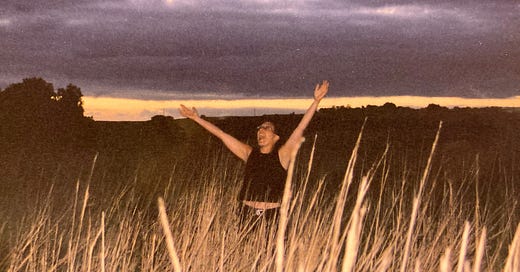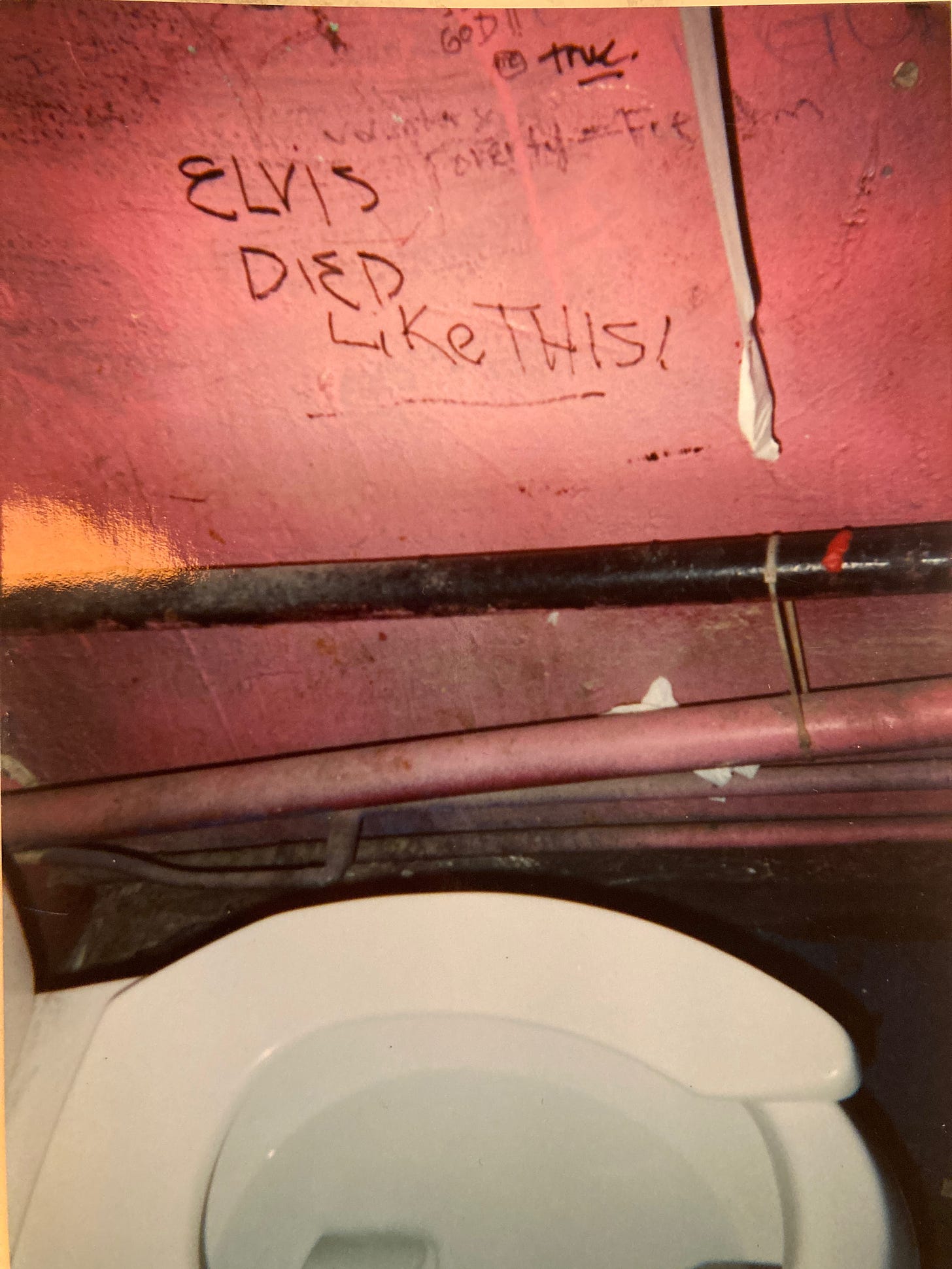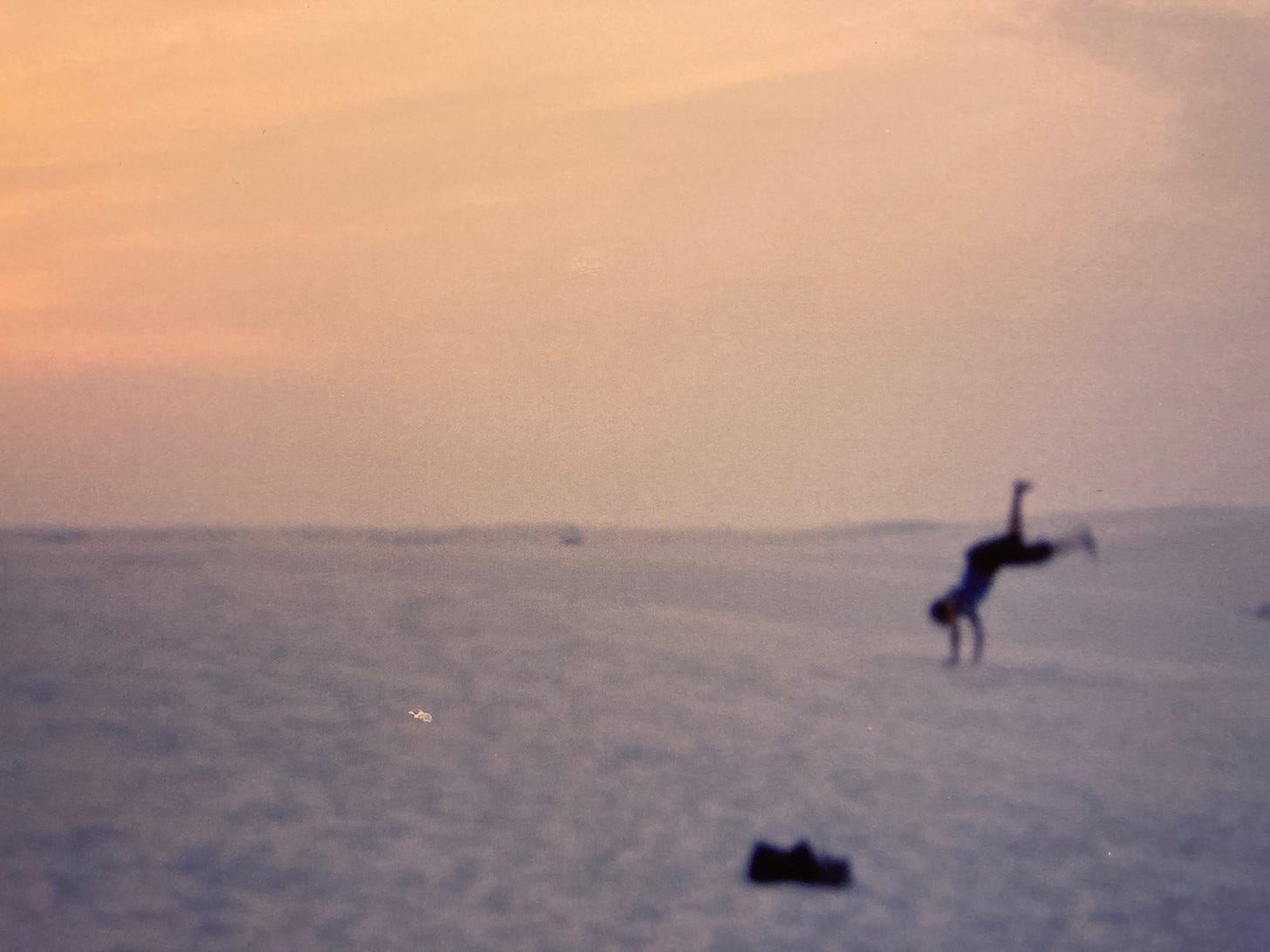Desperately seeking some comic relief, I thought I’d turn a word we’ve heard (or thought we heard) from Trump in his earliest campaign era of 2015 (our salad days when we were green in judgment) into a light-hearted journey ISO the spectacular and strange across America. The bigly-est things.
WORD SALAD
Remember when Trump was just an SNL character who would lose soon enough and we could just snottily mock his basket-of-deplorables vocabulary in the meantime until he fecked off? Many times it sounded to audiences like he said “bigly,” starting with the televised debate between him and Hillary.
“I’m going to cut taxes bigly and you’re going to raise taxes bigly, end of story.”
But that was just the beginning of the story that sent the internet buzzing. Did he really just say “bigly?” The transcription of the debate from various sources (CNN, WashPo, the Associated Press) heard this instead as “big league.” And if you lean in and listen, you can hear that second g. Still, the fun continued since whatever he says never quite comes out in coherent speech. “We’re going to win bigly,” quoted the Guardian. Iran was going to take over Iraq “bigly,” as he said according to Dictionary.com. And the NY Daily News, which should know a Queens accent when it hears it, had him uttering a line about how Obamacare was going to kick in “really bigly.”
The British, who know proper English, and enjoy an endless repertoire of creative curse phrases we could use evermore of right now, wrote an article unpacking this in an old post from the BBC. They did dig out sources that attested that “bigly” is ok, if uncommon.
Lots of those who heard “bigly” for the first time last night assumed it had been a neologism invented by the GOP candidate, much as former Alaska Governor Sarah Palin once urged Muslims to “refudiate” plans for a mosque in lower Manhattan.
But they were wrong. “It’s a word,” says Fiona McPherson, a senior editor with the Oxford English Dictionary.
“Bigly” can mean "“with great force”, she says. Thomas Hardy uses it in Far From the Madding Crowd to mean “proudly, haughtily, pompously,” McPherson adds. The OED lists an adjectival definition: “Habitable, fit to dwell in; (hence) pleasant.”
The US reference book company Merriam-Webster agrees that “bigly” is a word.
“Yes, ‘bigly’ is in the dictionary,” it tweeted after the debate. It defines “bigly” as an adverb meaning “in a big manner” or, archaically, “in a swelling blustering manner”. But it also added in a separate tweet, “That’s not what Trump said.”
They are likely right, as Trump continued to Tweet “big league” but never “bigly.”
@oreillyfactor please explain to the very dumb and failing @glennbeck that I supported John McCain big league in 2008, not Obama!
@club4growth asked me for $1 million. I said no. Now falsely advertising that I will raise taxes. I’ll lower big league for middle class.
Surprise, @oreillyfactor used my name big league in pre-ads to promote the show—then talked about everything else but me!
“@ryanbushby: i bet you have some great ideas on how to turn this country around” I do, big league!
And in another article on this on NPR, they had a linguist feed the expression through an audio analysis—verdict “big league”—and found further examples of Trump saying it on his Apprentice show and all the way back to the 1990s. Well, since that’s cleared up, he still left us at least with the impression of this new old word “bigly” to mimic him with to this day. And, even if he means “big league” he still sounds like an uneducated ninny.
Wasn’t that quaint when we could parse words of the candidate, a million years ago measured in Trump years. Now we’re eons past that, grizzled gray or bald from ripping our hair out. We can’t get so caught up in the stupid words when the deeds are so disastrous and tossed about so rapidly and willynilly. We need to battle for our lives and rights and dignity and the very soul of America before his big flush (of either him or us, hard to tell), but before that, could we just take a quick tour to remind ourselves why it’s all worth fighting for? I need some R&R, beauty and wonder, so let’s…
WANDER
Before we lived (and died of daily panic attacks) online and fretted over every syllable uttered from invented celebrities in social stream ad nauseum, we had sweet, simple things like the grand American Road Trip. My college friend Alissa and I—in light of her having to go to a family wedding in Colorado and me wanting to hand-deliver a disk with a copy of my first novel to be published by Livingston Press in West Alabama—decided in the summer of 2002 to kill these two birds in one large silly loop of the land in an old Volvo. She was afraid of flying, and I had aspirations of stopping by my founding father lit-hero William Faulkner’s estate. I also had this new book, Eccentric America by Jan Friedman, from the abundant “book table” at my dot-com job writing book reviews, so why not connect all the dots around America—weirdly. Our timeline depended on making it to that wedding on time, and we had this vision of arriving at White Sands, New Mexico on the night of the full moon. There would be tranquility and vistas, the requisite amber waves of grain, but also, the oddest entries in the guidebook that happened to fall somewhat along the zigzag of our travel line, the best little hoardhouses in America.
Here’s a few of our trip highlights (as blurbed in our Eccentric guidebook), in non-geographical order, with some further contemporary research to see the state of these time capsules over 20 years later:
Swetsville Zoo, Fort Collins, Colorado, with Bill Swets and his “bizarre menagerie of 160 insects, birds, dinosaurs and robots all made from scraps of metals, car parts, farm equipment tools, and machinery… It’s a labor of whimsy and Bill’s just in it for the love of it; it doesn’t cost you anything to enjoy his obsession.”
Update: The rusty steel “zoo” closed in 2022 when the family sold the farm for commercial development and auctioned off some of the art when their 82-year-old grandpa was bailing for Texas; at least the developer vowed to integrate the remaining art into its plans.
Johnson Museum of the Odd, Lincoln, Nebraska, “where Charlie Johnson displays oddities that cover almost every square inch of his house, including floors, walls, and ceilings. What makes this such an astonishing place is not that the objects themselves are so odd, but rather that the sheer number of them is so overwhelming. Charlie’s lifelong collection of bric-a-brac includes Beta videocassette tapes, severed doll heads, squeaky rubber animals, comic books, bubble bath containers, plastic beads, religious icons, macabre trinkets and so very, very much more, all meticulously organized.”
Update: Sigh, it’s gone. As of June 2012, someone reported the house was for sale. Sadly, I found Charlie’s obit from 2023, where it said he had a Master’s in English, was a writer of sci-fi and fantasy, and the founder and curator of this celebrated “residence of artistic assemblage.” Not only was he a passionate collector of oddities but also, people. “Those left to grieve include his partner of over thirty years, Lisa Good of Lincoln and his cherished collection of many good friends.”
Mason’s Bar Penis Bone Collection, Lambertville, New Jersey, obviously worth the detour. Jack Mason’s “collection of animal shafts hangs from the ceiling of Mason’s Bar in Lambertsville. Bulls, bears, boars, sheep, and frogs have given their all to satisfy your curiosity.” We entered the quaint watering hole, ordered our beers, and looked around feeling foolish and wondering why we couldn’t find the bone collection and how awkward to have to ask. I pictured some small display over the juke box or something. Certainly we wouldn’t want to offend anyone over the size of this type of collection. Wait, what’s that substantial walking stick with a hook at the end dangling over the pool table? Oh my, it’s a whale penis! Eegads, that’s a lot.
Update: The owner retired and sold the bar in 2005, taking his crooked shafts with him, said one commenter on Roadside America, and damn why didn’t we notice and buy one of those $3 postcards of the collection! Priceless. Since then, Jack is remembered in his obit from 2007 as Jesse, Jr., 95, the long-time owner of a septic tank business in Lambertville from 1938-1980, which overlapped with owning this low budget bar for 67 years. There’s no mention of the whereabouts of the (un)sexy collection, only that he liked to go fishing.
Mütter Museum, Philadelphia, Pennsylvania, classic home of a “grossly distended colon measuring five feet long and almost a food in diameter,” among 20,000 other medical specimens showcased often pickled in jars at the College of Physicians. This place is the best, if you don’t mind the musty smell. Though not free, it’s worth it for its “fluid preserved specimens, obsolete medical instruments, skeletons, bones and wax models of diseases, combining the collection of many individual doctors. One such doctor in the 1920s carefully catalogued 2,000 objects, removed from the human body, that got there either by swallowing or inhaling: buttons, pins, needles, jewelry, coins, toy jacks, nails and even a bullet.”
And, famous body parts: a tumor removed from President Cleveland’s jaw, the thorax of John Wilkes Booth, bladder stones from a Supreme Court justice. What could be finer.
Update: like many museums and historical sites that have to rethink their angle on history and presentation, the Mütter is getting meta with its Postmortem Project, an exhibit that started last spring and is ongoing and evolving through 2025.
A thought-provoking exploration that delves deep into the very heart of ethical questions surrounding future exhibition themes and consent regarding human remains. We are seeking community input as we continue to explore our ‘Birthplace of American Medicine’. Part exhibition, part event, and all community-driven, this multifaceted project invites you to engage with complex themes of respect, consent, and ethics, challenging you to ponder the intricacies of collection, care, interpretation, and display.
Doc’s Bottle House, Hillsville, Virginia, is the doing of pharmacist John Hope who saved about 10,000 bottles in the 1940s which he used to build “a one-room cottage his children used as a playhouse. The walls are formed using bottles of all kinds—clear, colored, gallon size and pint sized—which are laid so that flat bottle bottoms are on the inside and the uneven bottle tops are on the exterior. The bottles light up when the sun shines through: at night a blue bottle chandelier provides illumination.”
Update: Doc’s Bottle house, as of 2018, “remains in excellent condition under the watchful eye of local preservationists, although it is still under private ownership.”
Graceland, Memphis, Tennessee, mecca of Elvis, where we came in as jaded northerners but perhaps got injected through our tour headphones with a love serum that had us weeping by the time we got to the fatal toilet where the bacon-clotted legend croaked.
Update: Had we gone now we might have skipped this stop since it would likely be beyond our budget. Minimum you can spend to see the mansion is $84 each; or there’s all kinds of new exhibits since 2022 to honor the 45th anniversary of his passing in 1977, along with 10 other exhibits from cars to cycles to his time in the Army, for $51 sans Graceland. Strangely, there’s also currently a Pompeii program that has nothing to do with the crooner but rather unearths artifacts from the ancient ash-buried city.
Finally, also off topic, a slight dead end that wasn’t weird at all, but rather decidedly closed for renovations.
Rowan Oak, Oxford, Mississippi, author William Faulkner’s home was locked tight for however long, so I, refusing to have come here for no reason, scoured the grounds for what felt like hours in search of a sign for the launch of my writing life: a four-leaf clover, which I did eventually find, despite Alissa’s growing impatience.
Update: Rowan Oak is back in business. “Rowan Oak was William Faulkner’s private world, in reality and imagination, and served as inspiration for much of his work for more than 40 years. The modified Greek Revival home sits on 33 acres just south of the historic Oxford Square and is open to the public year-round.” I have no idea what became of that clover but I’m certain you could find another.
In this terrible time of division of despair, it’s essential to both step back to see the bigger picture and zoom in to admire the granular detail, the strokes of tender madness in every cranny of the country no matter red or blue, these blades of grass. The vastness steeped in wonderful weirdos like Charlie Johnson, Jack Mason, Bill Swets. Of bottles packed with nonsense worth celebrating. Of fleeting or enduring bones and stones. Brilliance like the books of Faulkner, always worth revisiting, amidst all the “Talk, talk, talk: the utter and heartbreaking stupidity of words,”
“...I give you the mausoleum of all hope and desire...I give it to you not that you may remember time, but that you might forget it now and then for a moment and not spend all of your breath trying to conquer it. Because no battle is ever won he said. They are not even fought. The field only reveals to man his own folly and despair, and victory is an illusion of philosophers and fools.”
_The Sound and the Fury
These aren’t distractions, not detours, not dead, but the very meat of what we’re made of, the sound and fury signifying everything.
[Appreciate what I produce here but don’t feel like committing to a paid subscription? Spare some change to Buy Me a Book.]








I'm looking forward to history books being rewritten so that "hamberder" is correct.
Thanks for this. It was oddly hopeful, which I'm sure was your intent. The innocence of our weirdness may be one of the best aspects of our country. And yes, I went to Graceland twice before it got so expensive, setting off the alarm in the Elvis Car Museum before being escorted out. I'd found out the night before at the motel across the street that I'd won a major short story contest and would have my first story published, so I was feeling the grace of The King. Couldn't resist touching his car.